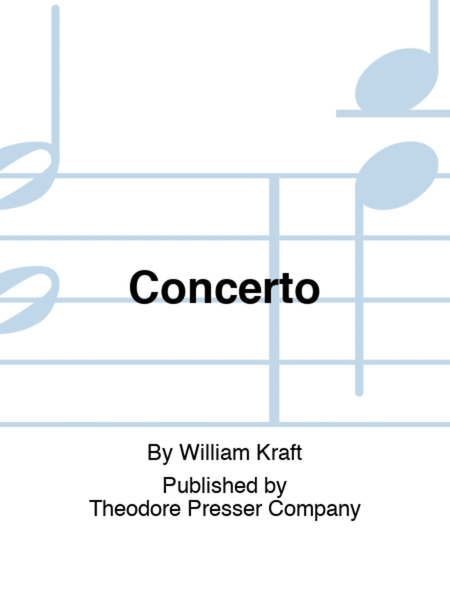Concerto
-
Ships in 2 to 3 weeks
Details
Description
SKU: PR.11641861SP
Composed by William Kraft. Part. 35 pages. Duration 21 minutes. Theodore Presser Company #116-41861SP. Published by Theodore Presser Company (PR.11641861SP).UPC: 680160685202.
What?! - my composer colleagues said - A concerto for the piano? It's a 19th century instrument! Admittedly we are in an age when originally created timbres and/or musico-technological formulations are often the modus operandi of a piece. Actually, this Concerto began about two years ago when, during one of my creative jogs, the sound of the uppermost register of the piano mingled with wind chimes penetrated my inner ear. The challenge and fascination of exploring and developing this idea into an orchestral situation determined that some day soon I would be writing a work for piano and orchestra. So it was a very happy coincidence when Mona Golabek phoned to tell me she would like discuss the Ford Foundation commission. After covering areas of aesthetics and compositional styles, we found that we had a good working rapport, and she asked if I would accept the commission. The answer was obvious. Then began the intensive thought process on the stylistic essence and organization of the work. Along with this went a renewed study of idiomatic writing for the piano, of the kind Stravinsky undertook with the violin when he began his Violin Concerto. By a stroke of great fortune, the day in February 1972 that I received official notice from the Ford Foundation of the commission, I also received a letter from the Guggenheim Foundation informing me I had been awarded my second fellowship. With the good graces of Zubin Mehta and Ernest Fleischmann, masters of my destiny as a member of the Los Angeles Philharmonic, I was relieved of my orchestral duties during the Hollywood Bowl season. Thus I was able to go to Europe to work and to view the latest trends in music concentrating in London (the current musical melting pot and showcase par excellence), Oslo, Norway, for the Festival of Scandinavian Music called Nordic Days, and Warsaw, Poland, for its prestigious Autumn Festival. Over half the Concerto was completed in that summer and most of the rest during the 72-73 season with the final touches put on during a month as Resident Scholar at the Rockefeller Foundation's Villa Serbelloni in Bellagio, Italy. So much for the external and environmental influences, except perhaps to mention the birds of Sussex in the first movement, the bells of Arhus (Denmark) in the second movement and the bells of Bellagio at the end of the Concerto. Primary in the conception was the personality of Miss Golabek: she is a wonderfully vital and dynamic person and a real virtuoso. Therefore, the soloist in the Concerto is truly the protagonist; it is she (for once we can do away with the generic he) who unfolds the character and intent of the piece. The first section is constructed in the manner of a recitative - completely unmeasured - with letters and numbers by which the conductor signals the orchestra for its participation. This allows the soloist the freedom to interpret the patterns and control the flow and development of the music. The Concerto is actually in one continuous movement but with three large divisions of sufficiently contrasting character to be called movements in themselves. The first 'movement' is based on a few timbral elements: 1) a cluster of very low pitches which at the beginning are practically inaudibly depressed, and sustained silently by the sostenuto pedal, which causes sympathetic vibrating pitches to ring when strong notes are struck; 2) a single powerful note indicated by a black note-head with a line through it indicating the strongest possible sforzando; 3) short figures of various colors sometimes ominous, sometimes as splashes of light or as elements of transition; 4) trills and tremolos which are the actual controlling organic thread starting as single axial tremolos and gradually expanding to trills of increasingly larger and more powerful scope. The 'movement' begins in quiescent repose but unceasingly grows in energy and tension as the stretching of a string or rubber band. When it can no longer be restrained, it bursts into the next section. The second 'movement,' propelled by the released tension, is a brilliant virtuosic display, which begins with a long solo of wispy percussion, later joined in duet with the piano. Not to be ignored, the orchestra takes over shooting the material throughout all its sections like a small agile bird deftly maneuvering through nothing but air, while the piano counterposes moments of lyricism. The orchestra reaches a climax, thrusting us into the third 'movement' which begins with a cadenza-like section for the piano. This moves gently into an expressive section (expressive is not a negative term to me) in which duets are formed with various instruments. There are fleeting glimpses of remembrances past, as a fragmented recapitulation. One glimpse is hazily expressed by strings and percussion in a moment of simultaneous contrasting levels of activity, a technique of which I have been fond and have utilized in various fixed-free relationships, particularly in my Percussion Concerto, Contextures and Games: Collage No. 1. The second half of the third 'movement; is a large coda - akin to those in Beethoven - which brings about another display of virtuosity, this time gutsy and driving, raising the Concerto to a final climax, the soloist completing the fragmented recapitulation concept as well as the work with the single-note sforzando and low cluster from the very opening of the first movement.

 Share
Share